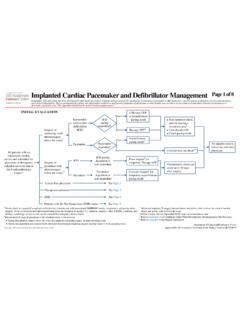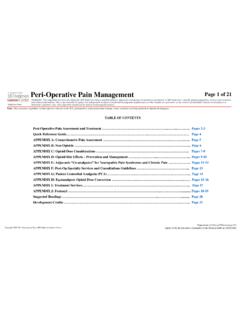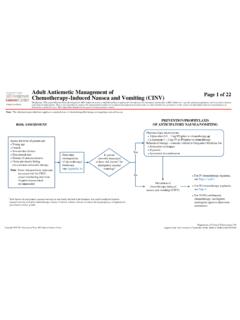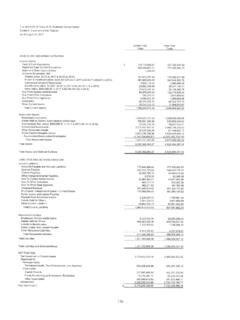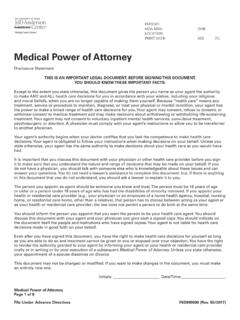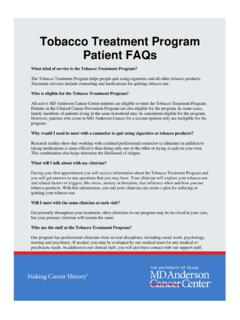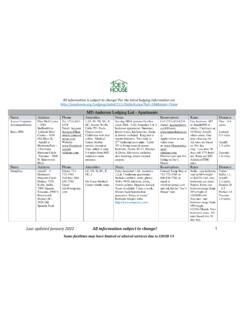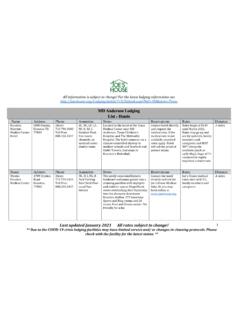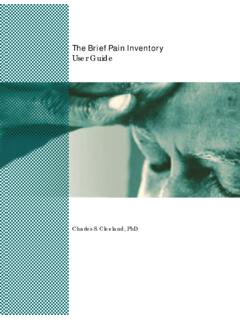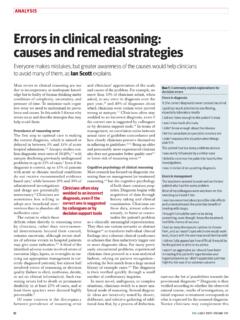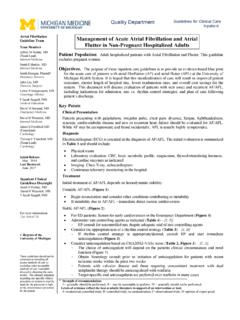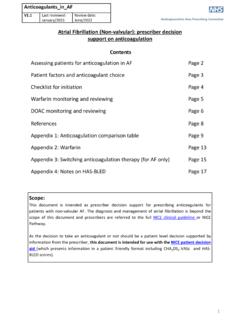Transcription of Clin Management Heparin IT Web Algorithm
1 Department of Clinical Effectiveness V10 Approved by the Executive Committee of Medical Staff on 01/18/2022 Heparin Induced Ab negative?Estimate probability of HIT using the Four T s 1 Consider Benign Hematology consult Discontinue all Heparin / Heparin flushes, low molecular weight heparins, and warfarin If patient on warfarin, consider reversing with vitamin K 10 mg PO or 5-10 mg IV Check Heparin antibody ( Heparin Induced Ab) Document diagnosis of HIT on the problem list and add Heparin to the allergy list with a comment noting patient has HIT Initiate therapeutic dose of a non- Heparin anticoagulant Critically ill patients or patients with high bleeding risk, potential for urgent procedures, life or limb threatening thrombosis present, or requiring dialysis: Argatroban or bivalirudin (see Appendix B) Stable patients without a high risk for bleeding: Rivaroxaban, apixaban, dabigatran or fondaparinux (see Appendix C) Moderate to severe hepatic dysfunction.
2 AVOID argatroban, rivaroxaban, apixaban, and dabigatran Moderate to severe renal dysfunction: AVOID fondaparinux and dabigatranIntermediate1 (score 4-5) or High1 (score 6-8)Low1 (score 0-3)Monitor platelets and signs and symptoms of thrombosis and continue/restart Heparin Page 1 of 8 Heparin Induced Thrombocytopenia (HIT) TreatmentDisclaimer: This Algorithm has been developed for MD Anderson using a multidisciplinary approach considering circumstances particular to MD Anderson s specific patient population, services and structure, and clinical information. This is not intended to replace the independent medical or professional judgment of physicians or other health care providers in the context of individual clinical circumstances to determine a patient's care. This Algorithm should not be used to treat pregnant (score 4-5)? Continue non- Heparin anticoagulation Bilateral lower extremity ultrasound to screen for deep vein thrombosis (DVT) If non-femoral central venous access present, bilateral upper extremity ultrasound to screen for DVT Transition anticoagulant when platelet count 150 K/microliter (see Appendix D) Discontinue all Heparin / Heparin flushes and low molecular weight heparins from home medication list Outpatient follow up as clinically indicated Stop non- Heparin anticoagulation Monitor platelets and signs and symptoms of thrombosis and restart Heparin as indicatedCheck serotonin release assay (SRA) to confirm diagnosisSRA negative?
3 Yes1 See Appendix A: The Four T sNoYesNoYesNoAPPENDIX A: The Four T sDepartment of Clinical Effectiveness V10 Approved by the Executive Committee of Medical Staff on 01/18/2022 Page 2 of 8 Heparin Induced Thrombocytopenia (HIT) TreatmentDisclaimer: This Algorithm has been developed for MD Anderson using a multidisciplinary approach considering circumstances particular to MD Anderson s specific patient population, services and structure, and clinical information. This is not intended to replace the independent medical or professional judgment of physicians or other health care providers in the context of individual clinical circumstances to determine a patient's care. This Algorithm should not be used to treat pregnant women.* First day of immunizing Heparin exposure = Day 02 ThrombocytopeniaPlatelet count fall > 50% and Nadir 20 K/microliterTiming* of platelet fall onsetThrombosis or other sequelaeOTher causes1 Onset between Days 5-10 orPlatelet count fall Day 1 with recent Heparin (past 30 days)Proven new thrombosis or skin necrosis; or Acute anaphylactoid reaction after IV Heparin bolusNone evident1 Platelet count fall 30-50% (or platelet fall > 50% due to surgery), or Nadir 10-19 K/microliterPossible0 Platelet fall < 30% or Nadir < 10 K/microliterOnset after Day 10 or timing unclear, or Platelet count fall Day 1 with recent Heparin (past 31-100 days)Progressive or recurrent thrombosis; erythematous skin lesions,suspected thrombosis (not proven).
4 Asymptomatic upper-limb deep vein thrombosis (DVT)DefinitePlatelet count fall < Day 4 without recent Heparin None1 Examples of other causes include, but are not limited to: chemotherapy, drug-related, sepsis, disseminated intravascular coagulation (DIC)To calculate the probability score, add the values from each T category based on presence of criteria Score 0-3: Low probabilityScore 4-5: Intermediate probabilityScore 6-8: High mg/ mg/ mg/kg/hourAPPENDIX B: Direct Thrombin Inhibitor (DTI) Dosing and Monitoring Bivalirudin Plasma half-life = 25 minutes(in healthy subjects)Metabolized by proteolyticcleavage with 20% renaleliminationNormal dosageAVOID or consider dosage reduction with the following: Child-Turcotte-Pugh2 score > 6, Total bilirubin > mg/dL, Heart failure Multi-organ system failure Severe anasarca Status post cardiac surgerySpecial dosing parametersDoseNotes and special considerationsMonitoring1 DTI2 mcg/ mcg/kg/minuteUse of this medication causes mild elevation of PT/INR results due to interference with testing1 See the Anticoagulant Management and Required Laboratory Monitoring Policy (MD Anderson Institutional Policy #CLN0984)2 See Appendix E for Child-Turcotte-Pugh (CTP) Scoring SystemDepartment of Clinical Effectiveness V10 Approved by the Executive Committee of Medical Staff on 01/18/2022 Page 3 of 8 Heparin Induced Thrombocytopenia (HIT) TreatmentDisclaimer: This Algorithm has been developed for MD Anderson using a multidisciplinary approach considering circumstances particular to MD Anderson s specific patient population, services and structure, and clinical information.
5 This is not intended to replace the independent medical or professional judgment of physicians or other health care providers in the context of individual clinical circumstances to determine a patient's care. This Algorithm should not be used to treat pregnant women. Baseline: Hgb/Hct, platelet count, aPTT/PT, serum creatinine, and hepatic function tests Therapeutic monitoring: aPTT 2 hours after initiation and dose changes to achieve specified target range per protocol Adverse effects monitoring: Hgb/Hct and platelet count daily Use of this medication causes significant elevation of PT/INR results due to interference with testing Do not discontinue this medication based on an elevated INR value Continue to monitor the patient for signs and symptoms of bleeding ArgatrobanPlasma half-life = 39-51 minutes (in healthy subjects)Primarily hepatic eliminationNormal renal functionCreatinine clearance < 30 mL/minutePatient on dialysis Baseline: Hgb/Hct, platelet count, aPTT/PT, serum creatinine, and hepatic function tests Therapeutic monitoring.
6 APTT 2 hours after initiation and dose changes to achieve specified target range per protocol Adverse effects monitoring: Hgb/Hct and platelet count daily APPENDIX C: Non- Heparin Anticoagulants Dosing and Monitoring1,2 Dose Adjustments/ConsiderationsDosingDrugDepa rtment of Clinical Effectiveness V10 Approved by the Executive Committee of Medical Staff on 01/18/2022 Baseline: Hgb/Hct, platelet count, aPTT/PT, and SCr Therapeutic laboratory tests: Routine monitoring not required. However, antifactor Xa levels4 may be useful in certain high-risk patients ( , obesity, malnutrition, renal insufficiency, and unexplained bleeding or thrombosis) Inpatient: Hgb/Hct, platelet count, and SCr at least once weekly Outpatient: Hgb/Hct, platelet count, SCr, and hepatic function tests at least once yearly If CrCl 30-60 mL/minute, SCr every 6 months If CrCl < 30 mL/minute, SCr every 3 monthsEdoxaban8 Use in liver disease: If CTP5 class C: use with cautionRenal: If CrCl is between 30-50 mL/minute: use with caution If CrCl is < 30 mL/minute: contraindicated Weight: For BMI 40 kg/m2: no dose adjustment necessaryElderly: For age > 75 years.
7 May have reduced clearance, use with caution1 Anticoagulant should continue if indication for long-term anticoagulation See the Anticoagulant Management and Required Laboratory Monitoring Policy (MD Anderson Institutional Policy #CLN0984)3 For concerns regarding affordability, consider submitting a test claim 48 hours prior to discharge via the Pharmacy Test Claim and Pre-Authorization Reports (PE CON) (for internal use only)4 Fondaparinux, apixaban, and rivaroxaban anti-Xa levels may be ordered as a send out lab using a miscellaneous test order and adding a note for Anti-Xa fondaparinux, Anti-Xa apixaban or Anti-Xa rivaroxaban assay as indicated5 See Appendix E for Child-Turcotte-Pugh (CTP) Scoring System6 Assessing for drug-drug interactions: Lexicomp or Micromedex 7 Dabigatran capsules should be swallowed whole and NOT opened, broken, crushed, or chewed8 Not currently on MD Anderson FormularyNo information available, therefore no recommendation can be madePage 4 of 8 Heparin Induced Thrombocytopenia (HIT) TreatmentDisclaimer: This Algorithm has been developed for MD Anderson using a multidisciplinary approach considering circumstances particular to MD Anderson s specific patient population, services and structure, and clinical information.
8 This is not intended to replace the independent medical or professional judgment of physicians or other health care providers in the context of individual clinical circumstances to determine a patient's care. This Algorithm should not be used to treat pregnant Baseline: Hgb/Hct, platelet count, aPTT/PT, SCr, and hepatic function tests Therapeutic laboratory tests: Routine monitoring not required. Apixaban and rivaroxaban: Antifactor Xa levels4 may be useful in certain high-risk patients ( , obesity, malnutrition, renal insufficiency, and unexplained bleeding or thrombosis) Dabigatran: Thrombin time (TT) may be useful in certain high-risk patients ( , obesity, malnutrition, renal insufficiency, and unexplained bleeding or thrombosis) Inpatient: Hgb/Hct, platelet count, and SCr at least once weekly Outpatient: Hgb/Hct, platelet count, SCr, and hepatic function tests at least once yearly If CrCl 30-60 mL/minute, SCr every 6 months If CrCl < 30 mL/minute, SCr every 3 monthsUse in liver disease: Apixaban: use in CTP5 class C not recommended and there is limited experience for use in class B Rivaroxaban: CTP5 class B or C: NOT recommended Dabigatran: No manufacturer recommendationsRenal: Dabigatran: If CrCl is < 30 mL/minute.
9 Avoid use Significant drug-drug interactions6: Apixaban and rivaroxaban P-glycoprotein CYP 3A4 Dabigatran P-glycoproteinClass specific contraindications: moderate to severe mitral stenosis or mechanical heart valve Fondaparinux(Arixtra )3 Indirect factor Xa inhibitorApixaban(Eliquis )3 Direct factor Xa inhibitorRivaroxaban(Xarelto )3 Direct factor Xa inhibitorDabigatran (Pradaxa )3,7 Direct factor Xa inhibitorHITT: 150 mg PO twice daily after 5 days of treatment with a parenteral non- Heparin anticoagulantIsolated HIT: 150 mg PO twice daily until platelet recovery Actual Body Weight: < 50 kg: 5 mg subcutaneously daily 50-100 kg: mg subcutaneously daily > 100 kg: 10 mg subcutaneously dailyHeparin Induced Thrombotic Thrombocytopenia (HITT): 10 mg PO twice daily for 1 week then, 5 mg PO twice dailyIsolated HIT: 5 mg PO twice daily until platelet recoveryHITT: 15 mg PO twice daily for 3 weeks, then 20 mg PO daily Isolated HIT: 15 mg PO twice daily until platelet recoveryCrCl = creatinine clearanceSCr = serum creatinine Begin warfarin mg PO daily and overlap with bivalirudin for a minimum of 5 days Stop bivalirudin infusion and obtain INR 4 hours after stopping infusion INR 2-3: continue with warfarin monotherapy INR < 2: restart bivalirudin and repeat above steps the following dayPreferred: Begin warfarin mg PO daily (maximum initial dose = 5 mg).
10 Do not use loading dose. Turn argatroban infusion off and begin fondaparinux at treatment doses Weight < 50 kg: 5 mg SQ Weight 50-100 kg: mg SQ Weight > 100 kg: 10 mg SQ After a minimum 5-day overlap of fondaparinux and warfarin, discontinue fondaparinux when the INR is between 2-3 and continue with warfarin monotherapyAlternate: Begin warfarin mg PO daily (maximum initial dose = 5 mg). Do not use loading dose. Overlap with argatroban for a minimum of 5 days. If argatroban dose 2 mcg/kg/minute and INR > 4, stop infusion and obtain INR 4 hours after stopping infusion INR 2-3: continue with warfarin monotherapy INR < 2: restart argatroban and repeat above steps the following day If argatroban dose > 2 mcg/kg/minute, reduce dose to 2 mcg/kg/minute for 4 hours and obtain INR (infusion dose can return to baseline after INR drawn) If INR 4: continue concomitant therapy If INR > 4: stop argatroban and obtain another INR 4 hours after stopping infusion - INR 2-3: continue with warfarin monotherapy - INR < 2.
